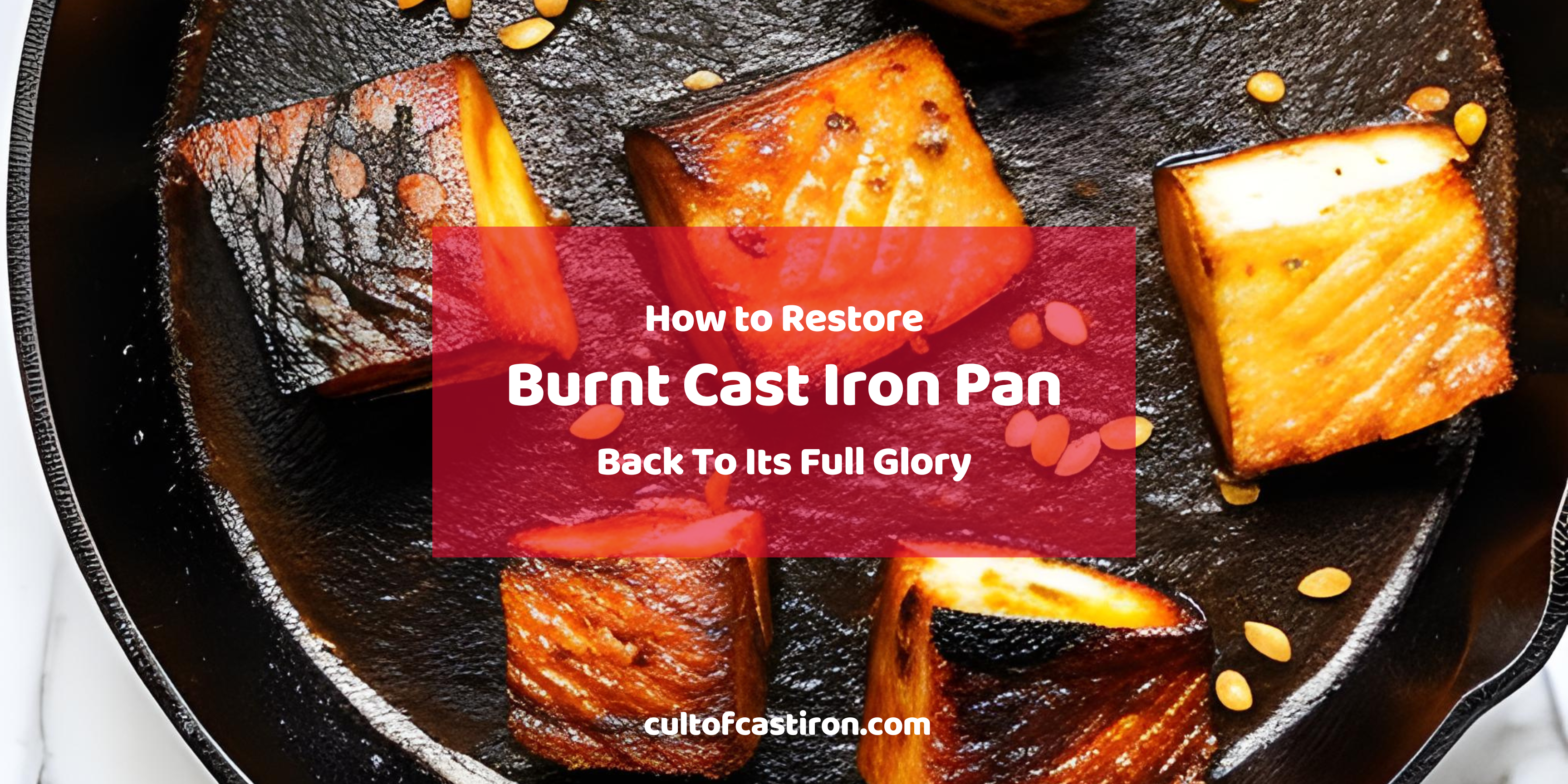Whether you’re a seasoned cast iron enthusiast or just starting your journey, you will face the challenge of a burnt cast iron skillet at some point. But worry not! We’re here to help you restore that pan to its former glory.
It’s important to remember that it’s not the cast iron pan that has burnt but rather the food and oil inside, leaving behind a tough to clean residue.
That’s why we’ve got your back with this guide, packed with easy instructions and valuable tips on how to restore a burnt cast iron skillet. Follow this guide, and you’ll have that cherished cookware piece ready for many more delicious meals!
How to Know if Your Cast Iron Pan is Burnt
You know your cast iron pan might be burnt when you see these clear signs:
- Visible burn marks on the surface
- Burnt food sticking on the surface
- A bitter aftertaste in food
- The seasoning looks “ashy”
- The seasoning is flaking off
Thankfully, the cast iron’s constitution will not be severely affected by this. However, it will take a toll on its seasoning as cleaning the burnt bits off may require using abrasives. Moreover, the seasoning itself may be burnt off as well, which manifests a flaky appearance. With that said, you can restore your burnt cast iron pan back to its former glory with a few minutes of work.
How to Restore a Burnt Cast Iron Pan
Cleaning a burnt cast iron pan becomes much easier with the right materials. Here’s what you’ll need to get the job done:
- Hot water
- Dish soap
- Soft-bristle brush or scouring pad
- Steel wool
- Dry cloth
- Thick towel or a trivet
- Baking soda or vinegar (optional)
Now, let’s bring your burnt cast iron pan back to life! Follow these simple steps:
1. Add water to the pan and let it boil
Add around 1 inch of water to your skillet and heat it medium. Let it simmer and eventually reach a boil.
2. Remove hot water and scrub the pan
Empty hot water from the skillet, scrub with a steel wool ball and dish soap until the blue-gray color of the bare cast iron shines through.
For non-severe cases, you can get away with just using a sturdy brush or scouring pad to preserve the seasoning. Try using baking soda as a gentle abrasive to remove gunk and neutralize odors or flavors.
3. Rinse and dry the pan
After rinsing off the gunk, wipe the pan dry with a clean cloth. After that you can choose between two ways to dry your cast iron pan:
- Oven drying: Set the oven temperature to 350°F (177°C), then place the pan in the oven for 10 minutes to ensure complete drying.
- Stove drying: Put the pan over medium-high heat for around 10 minutes. Let the water evaporate, leaving your pan nice and dry.
4. Apply oil to the pan, then stow it away
Grab a paper towel and apply a thin layer of neutral oil. You can use oils like vegetable, grapeseed, or flax. These won’t smoke too much when exposed to high heat. Store your pan in a clean, dry place, away from excessive moisture. Usually, that’s all you need to do if the damage is not severe enough.
However, if your pan’s seasoning was severely affected by all the scrubbing, you should apply a new layer to get its non-stick quality back up to speed. Here’s a complete guide I wrote for seasoning cast iron cookware.
How to Remove Burn Marks from Enameled Cast Iron Pans
Since enameled cast iron pans do not have seasoning, their burn marks are a little different compared to regular cast iron pans. Moreover, gentle care is essential when cleaning burn marks from an enameled cast iron pan. The enamel surface requires special attention to avoid damage. Here’s a method that works wonders for removing burned-on messes from your enameled pan.
1. Add water, let it boil, and sprinkle baking soda
Fill the pan with water and put it on the stove over medium heat. Wait for it to start boiling. Grab two tablespoons of baking soda and sprinkle it into the pan. Give it a good stir and let it simmer for a few minutes.
2. Scrape the pan
Get yourself a wooden spoon and gently scrape off those stubborn burned bits from the pan. Take a moment to check the water and see if those stubborn stains are giving in and releasing.
3. Use bleach for tough burn stains
For tough burn stains, mix three tablespoons of bleach with water and soak the cookware’s interior for 2-3 hours. This should leave your enamel looking like its brand new.
4. Rinse and dry the pan before storing
After using the baking soda/bleach and water solution, pour it down the drain and thoroughly rinse. Wipe your pan dry with a soft cloth or towel to remove all moisture before storing it.
Tips for Preventing a Burnt Cast Iron Pan
Avoiding a burnt cast iron pan is about taking care of your cookware and paying attention while cooking. Here are a few tips to keep your cast iron pan in tip-top shape:
Know your seasoning oil’s smoke point
The smoke point is when oil starts to smoke and degrade, causing a burnt taste and burning your pan. Use an oil with a suitable smoke point for your cooking temperature.
For high-heat cooking like stir-frying, use canola or grapeseed oil. They have high smoke points, hence they won’t start polymerizing and burning as you cook. Moreover, they are neutrally flavored, which means they won’t overpower the natural flavor of your food.
Get a feel for your stove’s heat output
Experiment with heat settings (low, medium, high) and observe their impact on cooking. Note the flame color—blue for high heat and yellow for gentler heat. With experience, you’ll master adjusting cooking times and temperatures for perfect results.
Avoid melting sugar in a cast iron pan
Melted sugar or caramel is acidic (pH 4.5-5) and can slowly erode cast iron. It’s also sticky and hard to clean without soaking or using soap. Furthermore, cast iron retains flavors, so using it for caramel can lead to unpleasant taste combinations like fishy, garlicky, or peppery caramel.
Preheat the pan and the oil before cooking
Preheating the oil is a game-changer as it prevents food from sticking to the pan. To do this, give your skillet 4 to 5 minutes to warm up for even heat distribution. Once preheated, lower the temperature slightly to prevent burning.
To check if the oil is ready, dip a wooden spoon and look for bubbles around the wood. If you see bubbles, it’s good to go! But if the oil starts smoking, no worries; just take the pan off the heat and let it cool down before trying again.
Don’t leave cooking food unattended
Properly monitor cast iron cooking to avoid sticking and burning. Unattended cooking is a fire hazard and leads to wasted ingredients and effort.
Avoid the Burn
A well-seasoned cast iron skillet is a kitchen treasure with its smooth dark shine, non-stick surface, and durability.
Preserving your cast iron pan is easier than you think. By following the tips above, you’ll be well on your way to savoring countless delicious meals. Follow the Cult of Cast Iron today and discover the incredible cooking experience this cookware offers. Happy cooking!

Miguel is a cast iron enthusiast from Cavite, Philippines. He works in the digital marketing field as a content marketing strategist. On the side, he manages a small online bookstore and tends to his plants.

